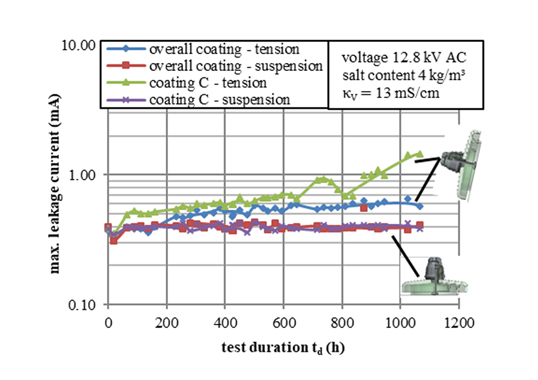Field experience with insulators having polymeric housings has shown that silicone rubber has become the material of choice due to its long-term dynamic hydrophobicity. At the same time, some silicone rubber formulations, especially from early generations of these insulators, have presented issues, including surface silicification as well as deep surface cracking and splitting.
This edited past contribution to INMR by Dr. Frank Schmuck, Convenor of former CIGRE Working Group D1.27 investigating these phenomena, advised what should be done if discovered.
Surface silicification is a type of deterioration that leads to layers of silica oxide forming on the housing, with thicknesses ranging from 100 to 300 µm. Unlike the virgin polymer surface, elasticity in the cross-section of the silica oxide layer is significantly reduced and shows brittle behavior when subjected to mechanical stress such as bending of sheds. If such deteriorated material is measured with respect to mechanical characteristics, there is reduction in tensile strength – even though tear strength is not necessarily affected. This can be explained by the fact that, when bent, the brittle silica oxide layer will break and the resulting crack leads to a ‘notch effect’ in the polymeric bulk material.

For example, different severities of damage were identified on silicone housed 420 kV instrument transformers installed in Central Europe and made with an LSR housing. The resulting deterioration was classified as either Type A or B, where in the first case there are only minor cracks when the sheds are bent (see Fig. 1). Type B, by contrast, is characterized by disintegration of the deteriorated material layer (as shown in Fig. 2). The years of manufacture of these insulators was from 1991 to 2007 and there was no direct correlation to time in service for cases of Type A, Type B or no deterioration.
Type B damage was considered the more critical since this mode was found all over the housing, including in areas protected against direct UV exposure. The level of severity was confirmed by scanning electron microscope analysis (see Fig. 3) that showed loss of material and crack formation into the bulk polymer. The LSR surface in this example was later sealed by an RTV coating to prevent pollution or moisture ingress into the cracks, which might risk further damage. This remedial measure proved successful and the affected instrument transformers remained in service.



FTIR analysis suggested hydrolytic processes as the root cause behind such deterioration. Unlike HTV silicone rubber, LSR material is not enriched with aluminum trihydrate (ATH) for improved erosion resistance. Instead, silica is used as filler to provide the mechanical properties required. One hypothesis was that the type of damage observed is possible if this filler has not had appropriate surface treatment.
Deep surface cracking or splitting is another form of deterioration that results in serious cracks through the entire housing. Such damage carries great risk since it exposes the rod, which is not outdoor-resistant. In case of pollution and moisture ingress, the interface between housing and rod is further attacked from the exposed area and a flashunder becomes likely.

This problem was initially investigated using a simple acid storage test with nitric acid having a pH of 0 chosen because this can be generated by corona discharges. Results showed that filler treatment is decisive in determining susceptibility of a material to being attacked by the acid. Without proper filler treatment, for example, one sample was shown to suffer substantially such that it showed deep cracking when bent after the test.
When considering what should be done if such problems are detected in service, there are two key issues:
1. Evaluating deterioration and estimating risk for continued use. IEEE Guidelines for Establishing Diagnostic Procedures for Live-Line Working of Non-Ceramic Insulators can be used as reference. As a ‘rule of thumb’, no level of housing damage should be accepted that allows the core rod to become exposed.
2. Since there is no principle to predict risk of further damage, it is recommended to annually inspect insulators from the supplier and vintage affected that are operating in the service area where this type of deterioration has been observed. In the case of silicification, but where the housing is still hydrophobic, affected insulators can remain in service because the silica oxide layer serves to shield the intact bulk material against further deterioration.









